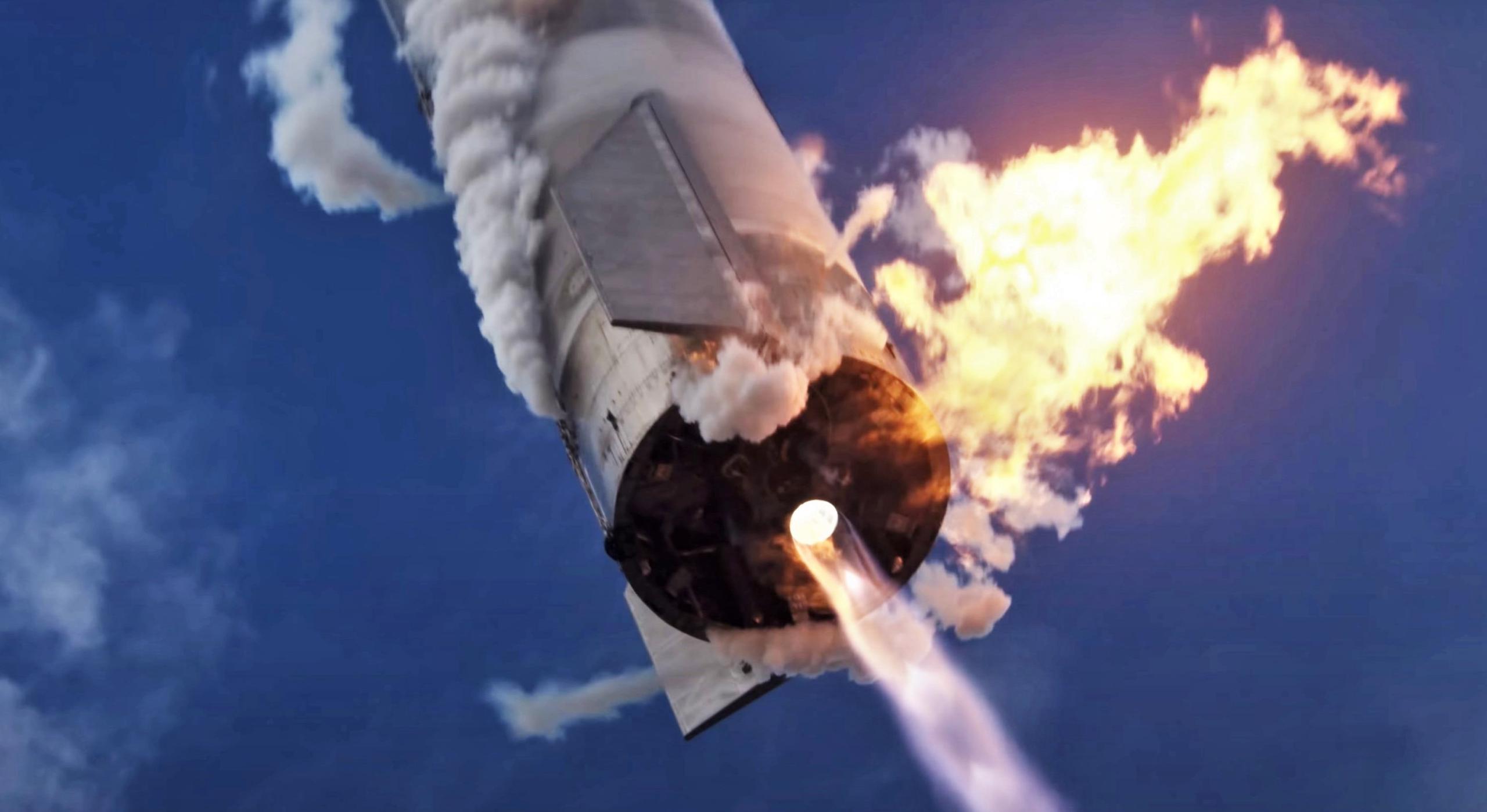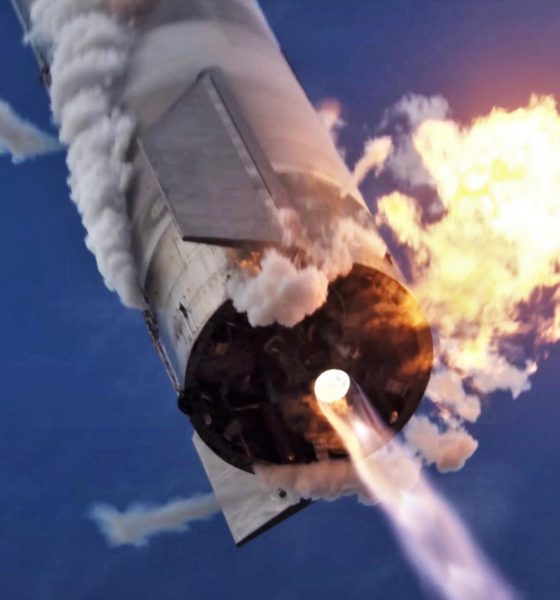

News
SpaceX recaps historic Starship landing in 4K as next ship readies for flight
SpaceX has published a new 4K video recapping Starship’s first intact landing after a high-altitude launch right as the company is preparing the next ship for flight.
On March 3rd, Starship serial number 10 (SN10) briefly became the first prototype to successfully launch to 10 km (6.2 mi), ‘skydive’ back to Earth, flip around, and land in one piece. Put simply, Starship SN10 made it unequivocally clear that the exotic, unproven method of landing selected by SpaceX could be made to work. Unfortunately, while Starship SN10 did land in one piece, the landing was much harder than planned.
Due to some combination of that hard landing and an apparent onboard fire that started in the last ~20 seconds of flight, SpaceX only had around six minutes to contemplate its success before Starship SN10’s propellant tanks were breached, violently depressurizing the rocket and causing a large explosion and fire.
Previously discussed on Teslarati, SpaceX CEO Elon Musk later took to Twitter to offer some educated guesses as to why Starship SN10 exploded.
“Starship SN9 ultimately failed a few seconds earlier than Starship SN8 when one of its Raptor engines failed to ignite, precluding a true flight test of the helium pressurization fix. As it turns out, Musk believes that that very fix may have doomed Starship SN10.
As Starship SN10 forged ahead past the points of failure that killed SN8 and SN9, the SpaceX CEO thinks that one or more of the vehicle’s three Raptor engines began to ingest some of that helium as they drained the methane header tank. As a result, engine thrust fell below expected values, preventing Starship SN10 from fully slowing down for a soft landing. Instead, the Starship hit the ground traveling a solid 25 mph (~10 m/s), obliterating its tiny landing legs and damaging its skirt section.”
Teslarati.com – March 10th, 2021
In other words, the losses of Starships SN8, SN9, and SN10 all share a relatively common point of failure – propulsion reliability. Technically, only Starship SN9’s failure can be blamed specifically on Raptor, one of which failed to ignite during its flip and landing maneuver. SN8 and SN10 both failed because of issues in the complex network of plumbing and pressurization systems responsible for feeding Raptors the right amount of propellant.
For SN8, the ship’s pressurization system failed to provide the necessary fuel head pressure at the last second, starving the Starship’s Raptors. SN10 ironically failed because the quick fix inspired by SN8’s failure – partially replacing a methane pressurant with helium – likely contaminated its methane fuel with helium, effectively watering down Raptor’s performance. While likely frustrating for SpaceX, the failures are still extremely valuable and loss of hardware remains a routine and intentional part of the company’s approach to iterative rocket development.
On the plus side, the FAA has already cleared SpaceX’s next Starship for flight after SN10’s momentary success and subsequent explosion. Spurred by that brief taste of total success, SpaceX wasted no time to prepare that next prototype – Starship SN11 – for flight and rolled the rocket to the launch pad mere days after SN10’s March 3rd flight. That very same day, SpaceX completed ambient pressure testing – a basic verification that Starship SN11 is leak-free.
A few days later, SN11 appeared to pass its first cryogenic proof test, replacing room-temperature gas with cryogenic liquid nitrogen. Three days after that, SpaceX attempted to put the Starship through its first triple-Raptor static fire test but appeared to suffer an abort milliseconds after a partial ignition of one or two of its three engines. Starship SN11 briefly caught fire and burned for at least 20-40 seconds after the abort, unsurprisingly triggering several days of delays. Nevertheless, if SN11 can make it through a second static fire attempt without issue on Thursday or Friday, the Starship is still well on track to take flight weeks earlier than any of its predecessors.

Elon Musk
SpaceX issues statement on Starship V3 Booster 18 anomaly
The incident unfolded during gas-system pressure testing at the company’s Massey facility in Starbase, Texas.

SpaceX has issued an initial statement about Starship Booster 18’s anomaly early Friday. The incident unfolded during gas-system pressure testing at the company’s Massey facility in Starbase, Texas.
SpaceX’s initial comment
As per SpaceX in a post on its official account on social media platform X, Booster 18 was undergoing gas system pressure tests when the anomaly happened. Despite the nature of the incident, the company emphasized that no propellant was loaded, no engines were installed, and personnel were kept at a safe distance from the booster, resulting in zero injuries.
“Booster 18 suffered an anomaly during gas system pressure testing that we were conducting in advance of structural proof testing. No propellant was on the vehicle, and engines were not yet installed. The teams need time to investigate before we are confident of the cause. No one was injured as we maintain a safe distance for personnel during this type of testing. The site remains clear and we are working plans to safely reenter the site,” SpaceX wrote in its post on X.
Incident and aftermath
Livestream footage from LabPadre showed Booster 18’s lower half crumpling around the liquid oxygen tank area at approximately 4:04 a.m. CT. Subsequent images posted by on-site observers revealed extensive deformation across the booster’s lower structure. Needless to say, spaceflight observers have noted that Booster 18 would likely be a complete loss due to its anomaly.
Booster 18 had rolled out only a day earlier and was one of the first vehicles in the Starship V3 program. The V3 series incorporates structural reinforcements and reliability upgrades intended to prepare Starship for rapid-reuse testing and eventual tower-catch operations. Elon Musk has been optimistic about Starship V3, previously noting on X that the spacecraft might be able to complete initial missions to Mars.
Investor's Corner
Tesla analyst maintains $500 PT, says FSD drives better than humans now
The team also met with Tesla leaders for more than an hour to discuss autonomy, chip development, and upcoming deployment plans.

Tesla (NASDAQ:TSLA) received fresh support from Piper Sandler this week after analysts toured the Fremont Factory and tested the company’s latest Full Self-Driving software. The firm reaffirmed its $500 price target, stating that FSD V14 delivered a notably smooth robotaxi demonstration and may already perform at levels comparable to, if not better than, average human drivers.
The team also met with Tesla leaders for more than an hour to discuss autonomy, chip development, and upcoming deployment plans.
Analysts highlight autonomy progress
During more than 75 minutes of focused discussions, analysts reportedly focused on FSD v14’s updates. Piper Sandler’s team pointed to meaningful strides in perception, object handling, and overall ride smoothness during the robotaxi demo.
The visit also included discussions on updates to Tesla’s in-house chip initiatives, its Optimus program, and the growth of the company’s battery storage business. Analysts noted that Tesla continues refining cost structures and capital expenditure expectations, which are key elements in future margin recovery, as noted in a Yahoo Finance report.
Analyst Alexander Potter noted that “we think FSD is a truly impressive product that is (probably) already better at driving than the average American.” This conclusion was strengthened by what he described as a “flawless robotaxi ride to the hotel.”
Street targets diverge on TSLA
While Piper Sandler stands by its $500 target, it is not the highest estimate on the Street. Wedbush, for one, has a $600 per share price target for TSLA stock.
Other institutions have also weighed in on TSLA stock as of late. HSBC reiterated a Reduce rating with a $131 target, citing a gap between earnings fundamentals and the company’s market value. By contrast, TD Cowen maintained a Buy rating and a $509 target, pointing to strong autonomous driving demonstrations in Austin and the pace of software-driven improvements.
Stifel analysts also lifted their price target for Tesla to $508 per share over the company’s ongoing robotaxi and FSD programs.
Elon Musk
SpaceX Starship Version 3 booster crumples in early testing
Photos of the incident’s aftermath suggest that Booster 18 will likely be retired.

SpaceX’s new Starship first-stage booster, Booster 18, suffered major damage early Friday during its first round of testing in Starbase, Texas, just one day after rolling out of the factory.
Based on videos of the incident, the lower section of the rocket booster appeared to crumple during a pressurization test. Photos of the incident’s aftermath suggest that Booster 18 will likely be retired.
Booster test failure
SpaceX began structural and propellant-system verification tests on Booster 18 Thursday night at the Massey’s Test Site, only a few miles from Starbase’s production facilities, as noted in an Ars Technica report. At 4:04 a.m. CT on Friday, a livestream from LabPadre Space captured the booster’s lower half experiencing a sudden destructive event around its liquid oxygen tank section. Post-incident images, shared on X by @StarshipGazer, showed notable deformation in the booster’s lower structure.
Neither SpaceX nor Elon Musk had commented as of Friday morning, but the vehicle’s condition suggests it is likely a complete loss. This is quite unfortunate, as Booster 18 is already part of the Starship V3 program, which includes design fixes and upgrades intended to improve reliability. While SpaceX maintains a rather rapid Starship production line in Starbase, Booster 18 was generally expected to validate the improvements implemented in the V3 program.
Tight deadlines
SpaceX needs Starship boosters and upper stages to begin demonstrating rapid reuse, tower catches, and early operational Starlink missions over the next two years. More critically, NASA’s Artemis program depends on an on-orbit refueling test in the second half of 2026, a requirement for the vehicle’s expected crewed lunar landing around 2028.
While SpaceX is known for diagnosing failures quickly and returning to testing at unmatched speed, losing the newest-generation booster at the very start of its campaign highlights the immense challenge involved in scaling Starship into a reliable, high-cadence launch system. SpaceX, however, is known for getting things done quickly, so it would not be a surprise if the company manages to figure out what happened to Booster 18 in the near future.








